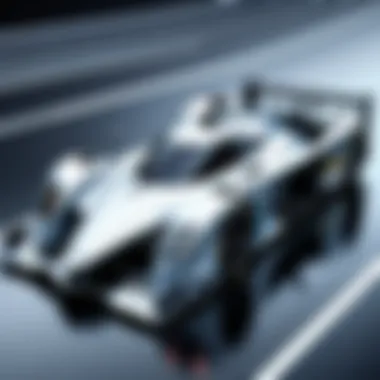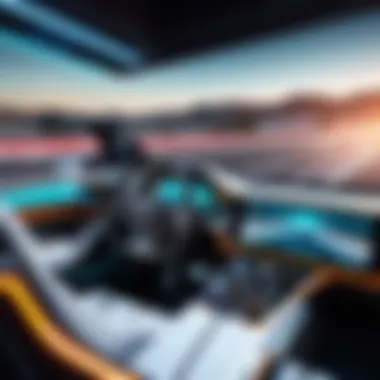Exploring the Evolution of Computer Racing Games


Intro
Racing games on computer systems have evolved significantly over the last few decades. This genre has captured the attention of gamers, leading to advancements in gameplay, graphics, and user experience. The sheer variety of racing games, from hardcore simulations to arcade-style racers, reflects a diverse audience. This article digs into the evolution, key genres, and notable titles that shape the landscape of racing games today.
In this analysis, we explore not only the game mechanics and design but also the technology behind them. We will touch upon user experiences in single-player and multiplayer modes. Additionally, we will consider how hardware innovations impact gameplay, offering a glimpse into the future of racing games. Through a careful examination of both universally recognized and niche titles, readers will gain insights that extend beyond mere entertainment to encompass the growing culture of competitive racing games.
Esports Coverage
The intersection of racing games and esports has created a dynamic environment for both players and fans. Esports coverage in this context focuses on the highly competitive tournaments, emerging player profiles, and strategic depth involved in team play.
Pro-Gaming Tournaments
Pro-gaming tournaments have become an integral aspect of the racing game community. Key events like the Formula E Racing series and the Virtual Le Mans attract thousands of viewers and significant sponsors. Participants showcase their skills in highly competitive environments. These tournaments often feature popular titles such as iRacing and Forza Motorsport, emphasizing real-world automotive dynamics.
Player Profiles and Interviews
Understanding the players who excel in these tournaments adds a layer of depth to the viewer experience. Interviews shed light on their backgrounds, training regimens, and strategies. Players often have unique narratives, transitioning from casual play to professional status, which inspires aspiring gamers.
Team Strategies and Analysis
Esports racing is not purely reliant on individual skill; team strategies play a crucial role. Teams analyze tracks, vehicle performance, and opponents’ tactics. Effective communication, collaboration, and practice are essential factors that differentiate top-performing teams from their competitors.
"The synergy between teammates can often lead to a higher probability of success in races, just as in traditional team sports."
Hardware Testing
In the world of competitive racing games, hardware plays a pivotal role in performance. Testing various equipment helps players find the right setup for optimal gameplay.
Reviews of Gaming Monitors
Gaming monitors are essential for precise visual feedback in racing simulations. Reviews often highlight refresh rates, response times, and adaptive sync technologies. Players prefer models that minimize lag and offer vibrant colors for a more immersive experience.
Performance Analysis of GPUs
Graphics Processing Units (GPUs) are crucial for rendering high-quality graphics. Performance analysis often examines how different GPUs handle complex race environments. Factors such as frame rates, resolution, and thermal management are considered, as they directly impact gameplay experience.
Comparison of Mechanical Keyboards
Mechanical keyboards are often favored by gamers for their tactile feedback and durability. Comparing various models helps identify which keyboards enhance gameplay responsiveness, thereby providing a competitive edge.
Game Reviews
The landscape of racing games is continually evolving. New releases often push the boundaries of gameplay and technology, providing fresh experiences for players.
Latest Game Releases
Staying updated on the latest game releases is important for enthusiasts. Titles like "Gran Turismo 7" and "F1 2021" have received attention for their realistic physics and graphics. These games often feature extensive career modes and online competition.
Detailed Gameplay Analysis
Gameplay analysis delves into the mechanics, controls, and realism of racing games. Titles that successfully replicate real-world driving physics are often more engaging. Features like tire wear, weather conditions, and vehicle damage add layers of challenge.
Storyline and Graphics Review
While narrative is often secondary in racing games, some titles incorporate compelling storylines. Games like "Need for Speed" have successfully blended racing with engaging narratives. Graphics review assesses aesthetics and realism, impacting players’ immersion in the game.
In summary, exploring racing games on computer systems reveals a multifaceted landscape. From esports coverage to hardware considerations and game reviews, the examination of this genre reflects its ongoing evolution. Understanding the nuances of competitive racing games and the technology behind them provides insights for both players and fans.
Prelude to Racing Games
Racing games have established themselves as a prominent genre in the gaming landscape, captivating audiences with their blend of speed, competition, and strategy. They are not only a source of entertainment but also a complex interplay of skill, reflexes, and technology. Understanding this genre is essential because its evolution illustrates broader trends in the gaming industry, including advancements in graphics, physics, and online features. The significance lies in both the thrilling gameplay and the technological innovations that drive immersive experiences.
Defining Racing Games
Racing games are centered around the competition of speed and maneuverability. They can feature various vehicles, including cars, motorcycles, and even futuristic modes of transportation. The objective is simple: to reach a destination faster than opponents. However, the intricacies of racing games often extend beyond sheer speed. Many titles incorporate elements like vehicle customization, track selection, and varied game modes, each offering unique challenges.
Genres within racing games range from arcade-style titles that emphasize fun and accessibility to simulation games that focus on realism and precision. The distinction is critical for understanding player preferences. For example, arcade racing games favor fast-paced, high-octane gameplay, while simulation racing games provide a more detailed experience where every aspect, from the car's handling to tire wear, is crucial.
The Appeal of Racing Games
The appeal of racing games can be attributed to several key factors:
- Excitement and Adrenaline: The thrill of competition and the rush of speed resonate deeply with players.
- Skill Development: Players seek to enhance their driving skills, making the gameplay satisfying. From mastering drifts to understanding racing lines, there is a learning curve that adds depth to the experience.
- Community and Competition: Racing games often feature robust online components that foster a sense of community among players. Competing against others can lead to friendships and rivalries, heightening engagement.
"Racing games create a blend of tension and excitement, pushing the gamer to improve with each race."
The genre continues to adapt and innovate, with emerging technologies influencing gameplay. Virtual reality, augmented reality, and enhanced physics engines contribute to more realistic and immersive experiences. As the genre progresses, it will be interesting to see how these trends shape the future landscape of racing games.
Historical Context
The historical context of racing games provides valuable insights into how this genre has developed and transformed over time. Understanding the origins and evolutionary path of racing games is crucial, as it allows one to appreciate their significance in the larger landscape of video gaming. It sheds light on the technological advancements and changes in player expectations that have influenced game design.
The early days of racing games were marked by simplicity. The appeal lay in the challenge of maneuvering vehicles around tracks, creating excitement and competition among players. By exploring this history, we recognize how racing games have grown from basic 2D representations to complex 3D simulations that closely mimic real-world physics and vehicle dynamics.
Additionally, analyzing the historical context highlights the impact of cultural and technological shifts on the gaming industry. As computing power has increased, so too have the possibilities for graphics, realism, and gameplay mechanics. This lays a firm foundation for understanding both the current state of racing games and the future trends that may shape their development.


Origins of Racing Games
Racing games trace their roots back to the early days of arcade gaming. The first notable title was Gran Trak 10, released in 1974 by Atari. This game was a top-down racing simulator that captivated players with its novelty. In the years that followed, games evolved rapidly. The introduction of more sophisticated arcade cabinets featuring forced feedback controls created a new layer of immersion.
During the 1980s, gaming technology began to improve considerably. Titles such as Pole Position made waves by introducing 3D graphics and more complex tracks. This marked a significant leap forward, as players began to immerse themselves in an experience that felt closer to real racing.
As the 1990s approached, consoles began to take center stage. The release of Mario Kart in 1992 combined elements of kart racing with character-based competition, establishing a beloved franchise that continues to be successful. Meanwhile, Need for Speed debuted, focusing on street racing and introducing police chases, engaging players with its narrative elements. These games created a strong foundation for the racing genre.
Evolution Through the Years
The evolution of racing games has been influenced by both technological advancements and changing player preferences. As computing power increased, game developers began to push the boundaries of what was possible. The introduction of 3D graphics in console games, such as Gran Turismo for the PlayStation in 1997, vastly improved visual fidelity, convincing more players to engage with racing simulations.
The early 2000s saw the advent of online multiplayer platforms. Titles like Forza Motorsport and Gran Turismo began to incorporate online racing features, allowing players worldwide to compete against each other in real time. This shift not only expanded the audience but also fostered a community of passionate gamers.
In recent years, the focus has shifted towards realism and user experience. Developers have integrated sophisticated physics engines and realistic damage systems, as seen in iRacing. These features provide players with a gaming experience that mimics real-life racing scenarios more closely than ever before. Such advancements maintain player engagement and have contributed to the growing popularity of esports among racing game enthusiasts.
As technology continues to progress, it becomes clear that the history of racing games is not just about the past; it shapes the future of this genre in ways that are still evolving today. The lessons learned from earlier titles inform current practices, ensuring that racing games remain a dynamic and compelling part of the gaming landscape.
Key Genres within Racing Games
Racing games have evolved significantly over the years, providing gamers with diverse experiences through various genres. Understanding the key genres within racing games is essential for both casual and competitive players. Each genre offers unique gameplay mechanics, styles, and challenges that appeal to different audiences. This article section breaks down these genres to illustrate their importance, benefits, and specific elements.
Arcade Racing Games
Arcade racing games are designed for quick play and easy accessibility. They prioritize fun over realism, allowing players to experience high-speed races without intricate mechanics. Popular titles in this category, like Burnout and Cruis'n USA, focus on innovative tracks, power-ups, and modifications to vehicles. The gameplay often includes exaggerated physics, such as impossible stunts and unrealistic handling characteristics.
Benefits of arcade racing include:
- Fast-paced action
- Simple controls for casual gamers
- Emphasis on entertainment over authenticity
This genre appeals to those seeking an instant thrill, making it a staple in arcade venues and home consoles alike.
Simulation Racing Games
In contrast to arcade games, simulation racing games aim to replicate real-world racing as closely as possible. Titles such as Forza Motorsport and Gran Turismo emphasize intricate vehicle dynamics and accurate track representations. Players are often required to understand mechanics such as tire wear, fuel management, and strategic racing. This genre's realism creates a steep learning curve, rewarding those who dedicate time to mastering the mechanics.
Critical aspects include:
- Comprehensive vehicle customization
- Varied racing conditions, like weather effects
- In-depth tutorials and assistance for new players
Simulation racers are often favored by enthusiasts who appreciate detailed mechanics and a more immersive racing experience.
Kart Racing Games
Kart racing games are characterized by their colorful visuals and whimsical themes. Games like Mario Kart and Crash Team Racing blend fun with competitiveness, featuring unique character abilities and imaginative tracks. These games offer features like item pickups that can drastically alter race positions, emphasizing the importance of strategy in addition to speed.
Key benefits of kart racing include:
- Accessible gameplay for players of all ages
- Engaging multiplayer modes
- Frequently changing dynamics due to item use
Kart racing often fosters a friendly, competitive spirit, allowing players to enjoy casual races with friends and family.
Rally Racing Games
Rally racing games simulate off-road racing experiences, appealing to those who appreciate rugged terrains and flexible racing styles. Titles like DiRT Rally and WRC focus on time trials and navigation through varied landscapes. The emphasis lies on mastering different road conditions, such as dirt, mud, and gravel.
Notable elements include:
- Varied environments impacting performance
- Navigation through checkpoints and stages
- Realistic car handling under diverse conditions
Rally racing games cater to players who enjoy a mix of speed and strategy, as drivers must quickly adapt to changing surfaces.
Street Racing Games
Street racing games delve into the underground racing scene, highlighting illicit events and custom car culture. Titles like Need for Speed and Midnight Club capture the thrill of racing while providing players with opportunities for vehicle customization and storyline engagement. Unlike traditional racing games, street racing focuses on gritty urban settings.
Main features include:
- Extensive vehicle tuning options
- Open-world environments
- Emphasis on style and reputation within the game world
Street racing games offer a unique fusion of racing and narrative, appealing to those who enjoy a story-driven approach alongside competitive gameplay.
Each genre within racing games brings unique shapes and styles, catering to various player preferences and interests.
Notable Racing Titles
Notable racing titles play a crucial role in illustrating the depth and breadth of computer racing games. They represent various styles, mechanics, and innovations that have defined the genre. Each title brings unique features, allowing players to explore different aspects of gameplay, whether it is through realistic simulations, arcade thrills, or competitive racing scenarios. These games often set benchmarks in design and technology, shaping the expectations of both casual gamers and serious racers.
Let's examine a few of the most influential racing titles that have captivated gamers and driven advancements in the industry.
Forza Horizon Series
The Forza Horizon series has established itself as a prominent title in the racing game genre. It merges open-world exploration with arcade-style racing. The dynamic environments and ever-changing seasons enhance the gaming experience. Players can race through vibrant cities and picturesque landscapes, with an extensive selection of cars to choose from. This variety makes it appealing to both casual and competitive players. One of the significant aspects of Forza Horizon is its engaging multiplayer features, allowing users to race against friends and others globally.
This flexibility encourages both social interaction and competitive play, showcasing why the Forza Horizon series has gained a dedicated fan base.
Gran Turismo Franchise


Gran Turismo is a hallmark of simulation racing. Renowned for its attention to detail, it offers players a realistic driving experience that mirrors actual racing. The game includes a vast array of vehicles, from everyday cars to high-performance race cars, appealing to a wide audience. Gran Turismo’s intricate physics engine allows for precise handling, making it a favorite for those seeking a more authentic experience.
The franchise has not only influenced personal gaming enjoyment but has also affected professional racing, as many players transition to real-world motorsports after getting a taste in the game.
Need for Speed Series
The Need for Speed series brings an exhilarating twist to the racing game landscape. Its incorporation of street racing culture and cinematic storytelling distinguishes it from other titles. Players engage in high-stakes races while evading law enforcement, adding a layer of excitement and challenge.
Moreover, the customization options in Need for Speed provide players with a chance to personalize their vehicles, further enhancing the appeal. Many fans are drawn to its thrilling narratives and the adrenaline rush it provides, indicating the series' vital role in shaping the genre's pop culture presence.
iRacing and Its Impact
iRacing is distinguished within the racing community due to its consolidation of online competitive racing. It offers a subscription-based model that provides real-time racing experiences against players worldwide. The physics and realism of the simulation set it apart from more casual experiences. This game emphasizes competitive skill and sportsmanship, offering various series for players to participate in. The sense of community and competition in iRacing plays a crucial role in the esports ecosystem, establishing it as a leader in simulation-style racing.
Project CARS Series
Project CARS focuses on delivering a comprehensive racing simulation experience. It offers an impressive scale of detail, allowing for a variety of race types, ranging from endurance races to short sprints. Acclaimed for its graphics and realistic driving mechanics, it requires precision and skill. This feature attracts serious racing enthusiasts who appreciate authenticity.
Moreover, Project CARS promotes a socially driven gaming environment. Players often share their experiences and set records, which fosters engagement and community-building. This aspect enhances the overall appeal of the game while underpinning its significance in modern racing games.
Technology Enhancing Racing Games
The realm of racing games has transformed significantly over the years, largely due to advancements in technology. As gaming systems become more sophisticated, the importance of integrating these technologies into racing games cannot be overstated. They serve not only to amplify the visual experience but also to enhance the realism and interactivity that players demand today. The incorporation of cutting-edge technology in racing gaming impacts everything from gameplay mechanics to the overall user experience. The continuous evolution in hardware and software provides developers the tools to create immersive worlds that engage players at every level. Below, we explore the critical aspects that technology brings to the racing game genre.
Graphics and Visual Fidelity
High-quality graphics play a pivotal role in the appeal of racing games. The level of detail in vehicle models, environments, and track scenery has reached unprecedented heights thanks to advanced graphical engines. Modern games utilize techniques such as ray tracing, which simulates how light interacts with surfaces, creating realistic reflections and shadows.
Players are drawn to visually stunning games like Forza Horizon and Gran Turismo, where the realism contributes to the thrill of racing. The use of 4K resolution enhances visual fidelity, allowing for greater detail in textures and environments. Notably, graphical advancements make it easier for players to navigate courses, as improved visibility aids in crucial racing decisions. This technological evolution results in an experience that is not just about speed but also about aesthetic enjoyment.
Physics Engines
A robust physics engine is critical in racing games, influencing how vehicles behave during gameplay. These engines simulate real-world physics in response to actions taken by players. They account for variables like weight distribution, tire friction, and aerodynamic drag, which ultimately affect vehicle performance.
iRacing is a prime example of a racing title that uses an intricate physics engine to deliver an authentic racing experience. Gamers are able to feel the weight of their vehicles, making each turn and drift a nuanced process requiring skill and precision. The realism offered by advanced physics engines helps players absorb themselves into the experience, enhancing their competitive edge.
Realism and User Experience
Realism is not solely confined to graphics and physics; it also extends to how players interact with the game. The user experience is vital to ensuring that the player feels like part of the racing world. Effective haptic feedback, detailed audio simulations, and customizable controls elevate the immersion.
Players expect a sense of control over their vehicles which is facilitated by technologies that allow for extensive customization of setups and driving styles. The integration of steering wheels and pedals, like those from Logitech, enhances this realism further, providing an authentic racing experience. Additionally, the accessibility of control schemes allows players to tailor their experience according to their preferences and skill levels.
"The evolution of technology in racing games is not just about visuals but also about creating a holistic experience that includes player interaction and environmental immersion."
With all these considerations, it becomes clear that technological advancements have not only reshaped the aesthetic appeal of racing games, but they have also fundamentally changed how players engage with these products. The future of racing games hinges on the ongoing integration of newer technologies, as developers strive to meet the expectations of a discerning audience that craves authenticity and excitement in their gaming experiences.
Overall, understanding how technology enhances racing games provides insight into their ever-evolving landscape. As graphics improve and physics engines become more complex, players can look forward to increasingly enriching experiences that keep them glued to their screens.
Online Multiplayer Features
The inclusion of online multiplayer features in racing games has significantly transformed how games are played and experienced. The reality of competitive racing now extends beyond the local arena, allowing players from various geographical locations to compete against each other in real time. This aspect not only enhances the social dynamics of gaming but also raises the level of competition, making the experience more thrilling and engaging.
Competitive Play
Online competitive play forms the backbone of multiplayer racing games. Players can engage in real-time races against opponents worldwide, often within ranked match systems that track performance and skill ratings. This competitive environment pushes players to improve their driving skills and racing strategies, as they are constantly challenged by others at similar or higher skill levels.
Beyond simply racing, many games offer features like leaderboards and season-based competitions, creating a sense of progression and achievement. Players often strive to improve their ranks, adding depth to gameplay that extends beyond the enjoyment of the race itself. Engaging in competitive play fosters a dynamic where players learn from each other, adapting to diverse racing styles and strategies.
Community Engagement
The online aspect of racing games facilitates active community engagement. Platforms such as Reddit or dedicated Facebook groups allow fans to share tips, tricks, and experiences. This interaction enhances the overall enjoyment of the game, as players can find companionship and discourse outside the races.
Additionally, many titles encourage user-generated content. Fans can create and share custom tracks, vehicles, and skins, enriching the community's creativity. Engaging with these communities often leads to friendships and collaborations that can further enhance the gaming experience. The bonds formed in these spaces can make a significant difference in how players perceive their time in the virtual racing arena.
Tournaments and Esports
The rise of racing games in the esports scene has marked a new era for competitive play. Tournaments, both large and small, draw players and spectators alike. Events hosted by professional organizations can feature substantial prizes and recognition, encouraging skilled players to participate. These tournaments often showcase the game’s capabilities while galvanizing the community around elite competition.
Esports in racing brings a level of professionalism to the gaming scene. Many renowned esports organizations establish teams, allowing top players to get sponsorships and make a career in gaming. The high-stakes nature of these events elevates the skills of participants and reinforces a culture of excellence within the community.
"The intersection of competitive play, community engagement, and esports forms the lifeblood of online racing games, continually evolving how players interact and engage with the title and with each other."
Hardware Considerations
In the realm of computer racing games, hardware considerations play a critical role in determining the overall experience. The interplay between software and hardware is essential for creating an immersive world that fulfills player expectations. Each component in a gaming setup contributes to the realism, fluidity, and responsiveness needed for competitive racing. Understanding these aspects can significantly impact gameplay and enjoyment.
Minimum and Recommended Specs
When discussing the hardware necessary for racing games, it is crucial to differentiate between minimum and recommended specifications. Minimum specs indicate the bare minimum a machine needs to run the game, while recommended specs offer a more pleasurable experience with enhanced graphics and performance.
For example, a racing game like Forza Horizon 5 may list its minimum requirements as:
- OS: Windows 10
- Processor: Intel Core i3-4170
- Graphics: NVIDIA GTX 650 or AMD HD 7750
However, for a truly captivating experience, recommended specs would include:
- OS: Windows 10 (64-bit)
- Processor: Intel i5-8400
- Graphics: NVIDIA GTX 970 or AMD RX 590


Choosing a configuration that meets or surpasses recommended specifications is advisable. This can lead to improved visual fidelity and reduced latency, both highly desirable in racing games.
Peripheral Equipment
Peripheral equipment can elevate the racing experience from simple enjoyment to an immersive simulation. The right tools can enhance feedback and expand gameplay possibilities. Several types of peripherals are worth consideration.
- Steering Wheels: Brands like Logitech and Thrustmaster offer various models that cater to casual gamers and professionals. A good steering wheel allows for more precise control compared to a standard controller.
- Pedals: Many racing wheels come with pedal systems that provide throttle, brake, and sometimes clutch capabilities. Brands also offer separate pedal sets that can improve realism and immersion.
- Cockpit Setups: Dedicated racing seats provide stability and comfort for long gaming sessions. These setups can often house wheels and pedals, creating a compact gaming station.
The investment in quality peripherals can greatly enhance the user's racing experience. It is about finding a balance between budget and performance while ensuring a solid feel and responsiveness while racing.
Optimizing Performance
To achieve optimal performance in racing games, several factors come into play. Proper system configuration and maintenance can lead to more enjoyable gameplay and reduce frustrations. Here are some essential tweaks and practices:
- Graphics Settings: Lowering settings such as shadow quality or texture resolution can improve frame rates without sacrificing enjoyment drastically.
- Updating Drivers: Keeping graphics drivers up to date ensures the best compatibility between the game and hardware, often resolving many issues.
- Cooling Systems: Efficient cooling systems prevent overheating, especially during intense gaming sessions. An overheated system may throttle performance, diminishing the gameplay experience.
In summary, a thorough understanding of hardware considerations enhances the enjoyment of racing games. From knowing minimum and recommended specs to investing in the right peripherals and optimizing hardware performance, each element contributes to an enriched gaming experience.
"The quality of the gaming experience often hinges on the relationship between hardware and software. A well-balanced synergy allows players to push their limits and enjoy the thrill of the race."
Optimizing hardware not only ensures better gameplay but also helps in enjoying the immersive aspects of racing games.
The Role of Modding
Modding plays a crucial role in the ecosystem of racing games, offering gamers the tools and flexibility to enhance and personalize their experiences. This aspect has shifted the landscape of gameplay, allowing users to transform standard features into something that resonates more closely with their preferences. The importance of modding cannot be overstated, particularly as it directly impacts community engagement and long-term player retention.
Customizing Gameplay
One of the primary benefits of modding in racing games is the ability to customize gameplay. Players can tweak various elements such as vehicle physics, graphics settings, and game rules. For example, in games like Assetto Corsa, players can install mods that adjust the handling characteristics of cars or create custom tracks. This opens the door for unique racing experiences, allowing players to experiment with different configurations that standard gameplay may not offer. Moreover, these modifications can enhance realism, making the game feel more engaging and challenging.
Some examples of common gameplay modifications include:
- Car skins: Custom paint jobs to personalize vehicle appearance.
- New tracks and environments: User-created content adds variety and exploration.
- Physics modifications: Changes to how cars interact with the environment, improving realism.
Modding not only personalizes the racing experience but also fosters a sense of ownership and accomplishment among players. It enables them to have a hand in shaping the game, cultivating a unique identity that can reflect their preferences and racing style.
Community Contributions
The racing game community thrives on contributions from its members via modding. These contributions often lead to lively exchange of ideas and innovation. Many developers encourage modding as it enhances the game longevity, keeping the player base active and engaged. Through platforms like Nexus Mods and RaceDepartment, users can share their creations, facilitating a collaborative environment.
Community contributions span various areas, including:
- Track Design: Users sharing custom-built tracks often push the boundaries of creativity, producing environments that offer fresh challenges.
- Vehicle Models: Modders can create highly detailed car models that may not be found in the base game, expanding the player's options.
- Gameplay Enhancements: Players can collaborate to design mods that improve UI or incorporate new game mechanics, ensuring that the game evolves over time.
Community-driven modding significantly enhances gaming experiences by ensuring content is continually updated and innovated upon. This aspect supports the emotional connection players forge with the game.
Future Trends in Racing Games
As racing games continue to evolve, understanding future trends is essential for both developers and players. This section examines key developments that are likely to reshape the racing game landscape. By focusing on the integration of virtual reality (VR) and augmented reality (AR), advancements in artificial intelligence (AI), and shifting player expectations, we can gain insight into where this exciting genre is headed.
Integration of VR and AR
The integration of VR and AR technologies in racing games represents one of the most transformative trends. VR offers an immersive experience, pulling players deep into the race. Players can feel the car beneath them and appreciate the intricate details of the environment. Games like Assetto Corsa and Project CARS have started incorporating VR support, enhancing realism significantly.
AR takes a different approach, overlaying digital information on the real world. This technology allows players to engage in racing scenarios that blend reality with virtual elements. As hardware becomes more accessible and affordable, it is likely more racing games will embrace these technologies. The future may bring games that allow players to race around their living rooms or local environments, creating a unique interaction with both the digital and physical worlds.
Advancements in AI
Advancements in AI are set to refine gameplay across various dimensions. Smart AI enhances the driving experience, making opponents more challenging and realistic. Games incorporating AI can simulate human behavior, resulting in unpredictable and varied race conditions. This means that players will no longer face the same scripted opponents; instead, they will encounter competitors who learn from their driving styles and strategies.
Moreover, AI can serve to enhance player experience through adaptive difficulty levels. The game can analyze a player’s performance and adjust challenges accordingly. This is particularly important for both novices and seasoned players, as it helps maintain engagement while preventing frustration or boredom.
Evolving Player Expectations
Player expectations are changing rapidly due to advancements in technology and gaming experiences. With increasing access to high-performance hardware, gamers seek more than just fun; they demand realism, immersive content, and robust community features. This shift is influencing developers to focus more on the user experience.
Players are now interested in how a game integrates social elements. Features such as sharing achievements, discussing strategies on platforms like Reddit, or showcasing skills on Facebook are becoming essential. The community aspect of gaming is growing, pushing developers to create online environments that foster interaction.
In summary, future trends in racing games underscore the importance of innovation. The integration of VR and AR enhances immersion, while AI advancements make gameplay more dynamic and responsive. Finally, understanding player expectations drives the creation of more meaningful and engaging experiences.
Finale
The conclusion serves as a critical component in any analytical piece, especially when discussing a diverse and evolving topic such as racing games on computers. This section not only wraps up the discourse but solidifies the insights presented throughout the article. Highlighting the key elements discussed enables readers to retain vital information, while also affirming the significance of racing games in the broader landscape of competitive gaming.
Recap of Key Points
The analysis traversed various dimensions of racing games, providing readers with a multifaceted understanding of this genre. Key takeaways include:
- Historical Context: The evolution of racing games showcases the genre's adaptive nature through technological advancements.
- Key Genres: Identifying and understanding the various sub-genres, such as arcade, simulator, and rally racing, helps in appreciating the diversity within racing games.
- Notable Titles: Highlighting iconic series like Forza Horizon and Gran Turismo illustrates the landmarks in racing game development.
- Technology Impact: The advancements in graphics, physics engines, and hardware have significantly shaped user experiences.
- Multiplayer Dynamics: Online features have transformed how players engage with racing games, fostering competition and community.
This recap serves as an outline of what the reader should take away, enhancing retention and reflection on their gaming experiences.
The Enduring Appeal of Racing Games
Racing games continue to captivate audiences for numerous reasons. One aspect is the inherent excitement of speed and competition. This genre elicits adrenaline and urgency, allowing players to engage in thrilling races from the comfort of their homes.
Moreover, the social aspect of racing games cannot be overlooked. Many players find joy in competing with friends or online communities. This dynamic fosters camaraderie and rivalry, making the experience more gratifying.
Another consideration is the constant evolution of technology that enhances gameplay. As graphics and physics simulations improve, players find themselves more immersed in realistic driving scenarios. This brings a new dimension to the game, making it appealing not just to casual gamers but also to serious racing enthusiasts.
Finally, the realm of esports has opened new avenues for competitive racing. Tournaments and leagues have transformed racing games into a legitimate competitive sport, increasing their appeal to a wider audience. Players are no longer just fans; many strive to become professionals in this engaging landscape.
In summary, the endurance of racing games stems from a combination of thrill, community, technological advancements, and competitive opportunities, making it a staple genre in gaming that engages a variety of players.



